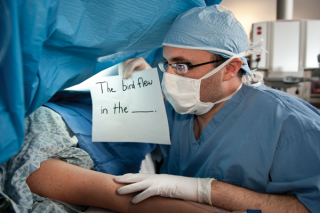Neuroscience
The Beneficial Mischief of Neurosurgery
We know neurosurgery is different—but often don't realize how different.
Posted May 5, 2014
(Note: This is part of a series of posts I’m writing in conjunction with my new book, The Tale of the Dueling Neurosurgeons.)

In vague way, I always knew neurosurgery was different—more delicate, more difficult, more demanding. After all, we say things like, “I’m no brain surgeon,” for a reason. Until recently, though, I didn’t realize just how different brain surgery is. I had no idea, for instance, that many neurosurgical patients remain conscious during operations. And not at some minimal, drooling, not-really-there level of consciousness, either. Most remain fully alert and awake, even chatting with doctors and nurses.
Even after seeing proof of this, I still have trouble believing it. I mean, for open heart surgery or joint replacements, patients always go under—you’d never even consider otherwise. But once we start digging around inside the most intricate organ in our body, we not only let patients stay awake, we seem to insist on it. How is this possible?
Well, although it’s the hub of the nervous system and the ultimate terminus of every nerve, the brain itself lacks enervation and therefore cannot feel pain. As a result, once neurosurgeons dull the scalp with novacaine (or something equivalent) and fold the skin back, the patient feels no discomfort. (This is doubly strange since pain, no matter where it originates, is largely a mental phenomenon anyway. You can see this fact clearly with phantom limbs, which often ache or cramp up despite the lack of any actual flesh to feel the hurt.) So that’s one answer to why patients stay awake during neurosurgery: they’re unlikely to buck with pain, and if you can avoid the potential complications of putting someone under, you might as well.
But there’s another, deeper reason for surgeons keep patients awake: the patients effectively tell the surgeons where to cut. Brains, you see, vary a lot from person to person—they vary as much as faces do. So even though surgeons can point to the general vicinity of Broca’s area or the auditory cortex or whatever, they’re only making a (highly) educated guess.
So, surgeons start many procedures by stimulating different patches of grey matter on the brain’s surface with electricity. They then ask the patients what they see or feel or hear with every spark. This gives the surgeons a detailed map of the brain and tells them what parts to definitely avoid. What’s more, as long as the patients can talk and describe their sensations, the surgeon knows that everything’s still functioning up there. It’s when patients go silent that you know something’s wrong.

As you might imagine, there are some incredible stories out there about what happens when you fiddle with people’s brains. The notorious lobotomist Walter Freeman loved recounting a tale from early in his career, when he stopped to ask a patient what was going through his mind at that moment. “A knife,” the man replied. Bluegrass musician Eddie Adcock wanted to make sure that he could still play the banjo after his brain surgery; life wouldn’t be worth living otherwise. So to insure that the fine-motor and music-processing parts of his brain remained intact, his doctors let him pick his banjo during the surgery. (Imagine providing the musical score for your own operation!)
My favorite stories involve the legendary neurosurgeon Wilder Penfield, an American who spent most of his career in Montreal. Penfield often worked near the brain’s speech centers, and he had a sense of mischief. Stimulating the speech centers never generated real language, mind you: electrical probes are too crude to make people talk against their will; it’s not like they were speaking in tongues. But Penfield could elicit basic sounds—an aria of aaaaah that got louder every second. Penfield could also arrest speech, and in fact often got patients talking only to cut them off. “I visited my daughter yesterd- aaaaah—” He challenged another man to keep quiet no matter what, to try as hard as he could not to say anything. The patient bit down, and Penfield even warned him when the zap was coming. It didn’t matter: the man sang like a canary. “I win,” Penfield said.
The mischief did have a serious purpose, though. As late as the 1950s neuroscientists had only a vague idea of what certain parts of the brain did; it was like those 1500s maps of the Americas, with fairly defined coastlines but huge blank spots in the middle. So Penfield played neuro-cartographer and used his electric probes (and occasionally, little jokes) to fill in many details. Penfield also had a deep interest in human consciousness and used his surgical sessions to explore how we store and access memories and where our stream of consciousness even comes from.
In most surgeries, patients don’t really participate once the anesthesia takes hold. At that point, surgeons might as well be operating on a chimpanzee, and you could aptly describe a heart surgery or kidney replacement as someone “being operated on,” in the passive voice. But brain surgery couldn’t happen without the patient’s own, active voice to guide the work. The patient is part of the surgical team here, perhaps the most important part, and above all that’s what makes neurosurgery different.


